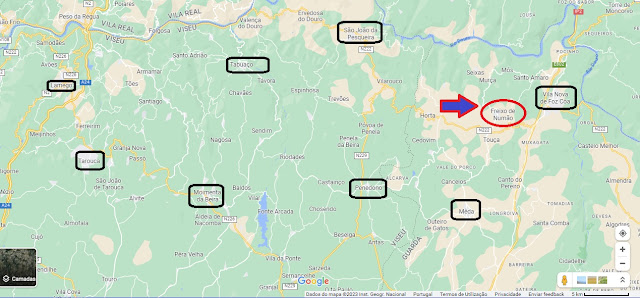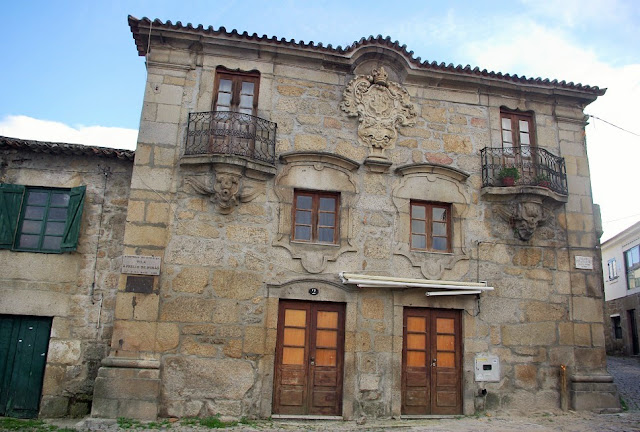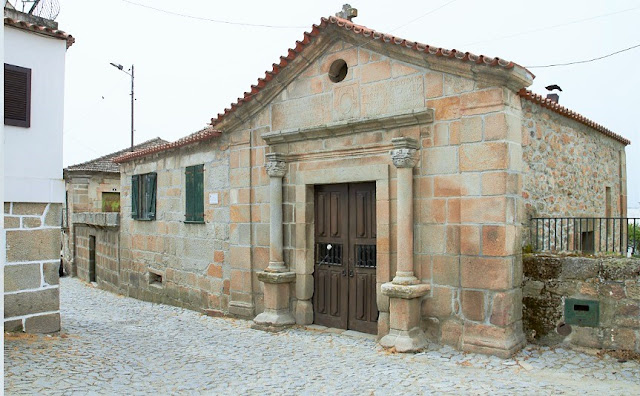FREIXO DE NUMÃO
41° 4' N; 7° 13' W
Freixo de Numão is a Portuguese village and parish in the municipality of Vila Nova de Foz Côa, with an area of 36.35 km² and 519 inhabitants (2021). Its population density is 14.3 inhabitants/km².
The current parish incorporates, since 2013, the territory of the then extinct parish of Murça.
History
The traces of human occupation in the area and end of the parish of Freixo de Numão are very old. Archaeological investigations that have been carried out since 1980 have brought millenary remains to light. In Castelo Velho, (located on the road to Santo Amaro, above the Ameixoeiras and Vale da Rata), excavations have allowed an in-depth study of the occupation, fauna and flora of the region. About five thousand years ago, a group of people built a castle there, with two lines of walls and a central tower. One can speak of a fortified settlement from the Chalcolithic (Copper Age), where about 40 people were housed! After a probable abandonment, on an undetermined date, it is once again occupied in the 2nd. millennium BC, in the middle of the Bronze Age. Ceramics decorated with cords and nipples, characteristic of these peoples, are abundant at this level of occupation. The houses would be made of wood coated with mud and covered with thatch, located against the walls, even to shelter from the strong winds that are felt there all year round.
From the same period will be the occupations at Monte de Santa Eufémia, which would function as a watchtower in the Chalcolithic and Bronze; the prehistoric shelters of Vale Ferreiro, Alto dos Barreiros, (above the Chapel of Nossa Senhora da Carvalha).
Until now, the beginning of occupation in the area that today constitutes the urban nucleus called Freixo de Numão parish is unknown. However, we already have material and dating of coals using the Carbon 14 method, which point to a large occupation during the Iron Age (1st millennium BC).
Iron materials have been sourced from the Casa Grande and Castelo areas. Other studies are planned within the urban area of Freixo de Nurnão, in order to obtain new dates.
Rome's soldiers must have arrived and easily dominated the indigenous peoples. The parish of Freixo de Numão, throughout the so-called old area, which is delimited by Casa Grande and Devesa, Paçal, Carrascal, Castelo, Açougue, Lages and even Cabo Lugar, has traces of a probable Roman Civitas, a probable Fraxinum ignored by the investigators, asleep by the winds of history.
Archaeological excavations in the areas of Casa Grande, Adro da Igreja, Largo de S. João, as well as monitoring the parish's sewerage network, allowed us to delimit the area of archaeological interest.
The Mother Church must have been, between the 1st and 5th centuries after Christ, a Roman temple. A votive altar, many decorative stones and a marble funerary vine, collected in the Church itself or in the surrounding area, attest to this.
There are dozens of places with traces of Roman occupation at the end of the parish of Freixo de Numão, some simple Casais (country houses) other important villas where agricultural and mining activities stand out. Lagaretas and mills already inventoried certify the importance of wine in the first centuries of our era, in this region. Archaeological excavations in Zimbro II, Salgueiro (workshop linked to the exploitation of white granite), Rumansil, Colodreira and Prazo, have allowed the reconstruction of a bit of the Roman countryside in the warm lands of the Douro.
There is no known trace of occupation by the so-called barbarian peoples (Suevi, Visigoths, Arabs). If we have no material left, much less the toponymy and, hence, a probable non-domination of these lands by these peoples.
In the 12th century, during the Reconquista, Numão and its Castle gained prominence, hence the subjugation of a large area of the current municipality of Vila Nova de Foz Côa to the Lord of Numão. However, between the 13th and 14th centuries, Numão lost control over some lands, which happened with Horta, Touça and Freixo de Numão (sometimes referred to only as S. Pedro de Freixo). These lands became autonomous, with their own jurisdiction.
At the beginning of the 16th century, Freixo de Numão was already the most populous town in the region, certainly due to the large number of Jewish families coming from Spain, newly unified by the action of the Catholic Monarchs (Fernando and Isabel). This population growth allowed for a revival that had only had a parallel during the period of Roman occupation (as shown by the materials exhumed in excavations already carried out).
Between the 17th and 18th centuries, Freixo was filled with beautiful manor houses, chapels were built, the Church and Hermitage of Nossa Senhora da Carvalha, the Town Hall (new) and the Pelourinho were rebuilt, among other initiatives such as construction of fountains, paths and piers.
Transport
Train
A few kilometers from the town, the historic Linha do Douro passes, which connects the parish with the rest of the country. In times it also served as a connection to Spain. It shares the station with the neighboring parish of Mós do Douro.
💓💓💓💓💓
SEARCH IN ALPHABETICAL ORDER
IN THE DISTRICT OF GUARDA

Aguiar da Beira;
Almeida;
Almendra;
Castelo Bom;
Castelo Melhor;
Castelo Rodrigo;
Celorico da Beira;
Figueira de Castelo Rodrigo;
Fornos de Algodres;
Freixo de Numão;
Golfar + A-do-Cavalo;
Almeida;
Almendra;
Castelo Bom;
Castelo Melhor;
Castelo Rodrigo;
Celorico da Beira;
Figueira de Castelo Rodrigo;
Fornos de Algodres;
Freixo de Numão;
Golfar + A-do-Cavalo;
Moreira de Rei (Trancoso);
Numão;
Pinhel;
Ranhados;
Sabugal;
Seia;
Serra da Estrela Nature Park;
Sortelha;
Trancoso;
Valhelhas;
Vila Nova de Foz Côa;
Vilar Formoso;
Numão;
Pinhel;
Ranhados;
Sabugal;
Seia;
Serra da Estrela Nature Park;
Sortelha;
Trancoso;
Valhelhas;
Vila Nova de Foz Côa;
Vilar Formoso;
💓💓💓💓💓
Return to mainland Portugal &
the Azores and Madeira islands
































